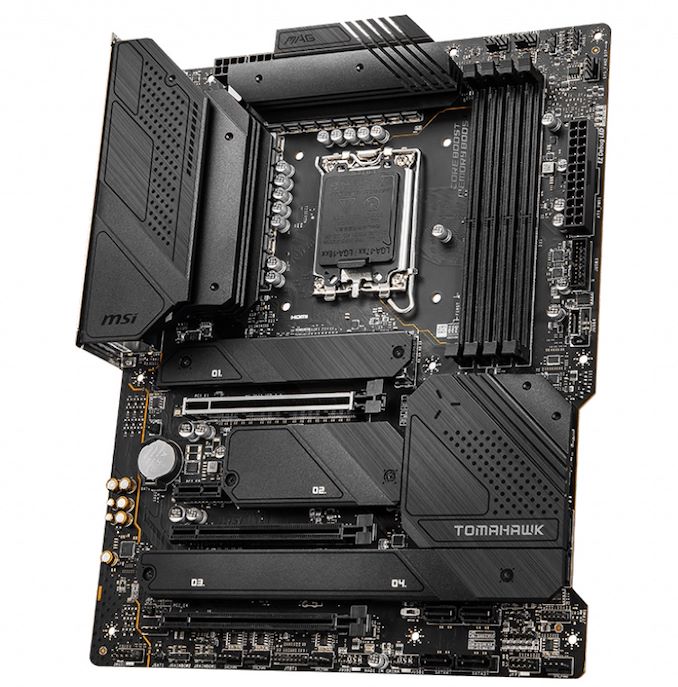The Intel Z690 Motherboard Overview (DDR5): Over 50+ New Models
by Gavin Bonshor on November 9, 2021 9:00 AM ESTMSI MAG Z690 Tomahawk WIFI (DDR5)
Perhaps one of the most bang for buck motherboard series in recent times is back for Z690, the Tomahawk. The MSI MAG Z690 Tomahawk WIFI includes a fairly premium feature set, but at a very reasonable price point, which puts it firmly in the mid-range of models. Looking at the aesthetics, the Tomahawk features an all-black design with matte and metallic contrasts throughout the rear panel cover, M.2 heatsinks, and the chipset heatsink for a two-toned look. Much like its Unify series, the Tomahawk drops integrated RGB LED lighting, but there's plenty of scope for users to add their own through the use of internal headers.
Focusing on PCIe support, the MSI MAG Z690 Tomahawk WIFI has one full-length PCIe 5.0 x16 slot, one full-length PCIe 3.0 x16 slot, and one full-length PCIe 3.0 x4 slot, as well as one PCIe 3.0 x1 slot. Storage on the Tomahawk consists of three PCIe 4.0 x4 M.2 slots, one PCIe 3.0 x4 M.2 slot, and six SATA ports capable of supporting Intel RAID 0, 1, 5, and 10 arrays. For memory, MSI includes four memory slots capable of supporting up to DDR5-6400, with a total capacity of up to 128 GB.
On the rear panel of the MSI MAG Z690 Tomahawk WIFI is one USB 3.2 G2x2 Type-C, three USB 3.2 G2 Type-A, two USB 3.2 G1 Type-A, and two USB 2.0 ports. Focusing on networking, MSI is using an Intel I225-V 2.5 GbE controller, with an unspecified Wi-Fi 6 CNVi offering both wireless and BT 5.2 compatibility. Users will find an HDMI 2.1 and DisplayPort 1.4 video output pairing, as well as five 3.5 mm audio jacks and S/PDIF optical output, and a small BIOS Flashback button.












126 Comments
View All Comments
Duwelon - Tuesday, November 9, 2021 - link
Asus' prices are completely bananas. If I build a new rig with Z690 it'll probably be my first non-Asus build in a very long time.Sivar - Tuesday, November 9, 2021 - link
That caught my eye, too. I bought an Asus Hero-branded board for my current system last year at approximately $200 USD.I suspect Asus is shifting their marketspeak because the word "Maximus" (used for the z690 board but not mine) usually applies to their most expensive boards.
blppt - Tuesday, November 9, 2021 - link
This. $2000 for a consumer grade motherboard? WTF are they smoking?Also, I'm pretty sure ASUS will be releasing some TUF Z690s at some point, probably at a lower price point than the primes. My experience with the TUF series has been very positive for the price.
DigitalFreak - Tuesday, November 9, 2021 - link
They know they're not going to sell many of those. Those boards are either for LN2 e-peen competitions or people with more money than sense.Wrs - Wednesday, November 10, 2021 - link
TUF is historically just a bit more expensive than Prime. They already have a TUF DDR4 version - ordered the Wifi one for $290 the other day. If worried about price DDR5 is the first mistake.blppt - Wednesday, November 10, 2021 - link
The X570 TUF was cheaper than the X570 Prime when I went shopping for an AMD board.COtech - Tuesday, November 9, 2021 - link
Subtitle - "Intel Z690 Chipset: Like Z590, But Now With Native PCIe 4.0"I think "But Now With Native PCIe 5.0" is intended.
gavbon - Thursday, November 18, 2021 - link
The Z690 chipset doesn't have PCIe 5.0, this comes from the CPU. The Z690 chipset does, however, now include PCIe 4.0 lanes, whereas Z590 did not.Someguyperson - Tuesday, November 9, 2021 - link
I don't get the "DP IN" ports on the ASUS ProArt Z690 Creator WIFI. I see the author just wrote what was on the ASUS website, but that doesn't really explain anything. Are they passthrough to the Thunderbolt out ports? Is there a capture card built into this motherboard? I'm very confused by the labeling here.uwsalt - Tuesday, November 9, 2021 - link
Those are passthrough to the Thunderbolt port. Add-in Thunderbolt cards work the same way. You slot in your discrete GPU, send the output from both DP ports to the Thunderbolt controller, and then use Thunderbolt to output to a Thunderbolt monitor or hub.